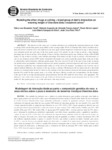Please use this identifier to cite or link to this item:
http://www.alice.cnptia.embrapa.br/alice/handle/doc/883667| Title: | Modeling the effect of age at calving × breed group of dam's interaction on weaning weight of Charolais-Zebu crossbred calves. |
| Authors: | TORAL, F. L. B.  TORRES JUNIOR, R. A. de A.   LOPES, P. S.   SILVA, L. O. C. da   REIS FILHO, J. C.   |
| Affiliation: | FÁBIO LUIZ BURANELO TORAL, UNIVERSIDADE FEDERAL DE MINAS GERAIS ROBERTO AUGUSTO DE A TORRES JUNIOR, CNPGC PAULO SÁVIO LOPES, UNIVERSIDADE FEDERAL DE VIÇOSA LUIZ OTAVIO CAMPOS DA SILVA, CNPGC JOÃO CRUZ REIS FILHO, MINISTÉRIO DA AGRICULTURA, PECUÁRIA E ABASTECIMENTO. |
| Date Issued: | 2010 |
| Citation: | Revista Brasileira de Zootecnia, v. 39, n.5, p. 1046-1057, maio 2010. |
| Description: | ABSTRACT - The objective of this study was to evaluate alternatives for modeling the interaction between age of dam at calving (AOD) and the dam genetic group (DGG) on the weaning weight (W225) of Charolais-Zebu (Ch-Z) crossbred calves. Data from 56,965 crossbred calves were analyzed by the least square method. Regression coefficients for age of dam at calving were estimated nested into each class of the dam genetic group (CLA model); for age of dam at calving × dam Charolais percentage (age of dam at calving × FCh) and age of dam at calving × dam heterozygosity (age of dam at calving × FH) (FChFH model); for age of dam at calving × dam Charolais percentage (FCh model); for age of dam at calving × FH (FH model); or only for age of dam at calving (NINT model). Segmented polynomials were used to model the general shape of the age of dam at calving effect and its interaction with dam genetic group. The knots were at 6.33 and 10.66 years of age of dam at calving and general linear and quadratic coefficient regression and specific quadratic coefficient regression after each knot were fitted. The regression coefficients were estimated nested within sex of the calf in all situations. According to the F test for sum of squared residuals differences, the inclusion of the age of dam at calving × FH interaction did not improve the fit of the model and the CLA model provided the best fit. However, the estimates of the age of dam at calving and dam genetic group interaction from the CLA model for dam genetic group × sex of the calf classes with few records were not appropriate, but the estimates of the age of dam at calving and dam genetic group interaction from the FCh model for those classes were appropriate. The differences were small in the estimates of the age of dam of calving and dam genetic group interaction from the CLA or FCh models for dam genetic group × sex of the calf classes with many records. RESUMO - Este trabalho foi realizado com o objetivo de avaliar alternativas para modelar a interação entre idade ao parto e grupo genético da vaca (GGV) sobre o peso à desmama de bezerros mestiços Charolês-Zebu. Dados de peso à desmama de 56.965 bezerros Charolês-Zebu foram analisados utilizando o método de quadrados mínimos. Foram estimados coeficientes de regressão para idade da vaca ao parto (IVP) dentro de cada grupo genético da vaca (modelo CLA); para IVP × fração esperada de alelos de origem da raça Charolesa na vaca (IVP × FCh) e IVP × fração esperada dos loci da vaca com um alelo proveniente da raça Charolesa e outro proveniente de raças zebuínas (IVP × FH) (modelo FChFH); para IVP × FCh (modelo FCh); para IVP × FH (modelo FH); ou apenas para IVP (modelo SINT). A forma geral do efeito da IVP sobre o peso à desmama foi modelada por polinômios segmentados com efeitos linear e quadrático gerais e quadráticos específicos, a partir de cada nó (6,33 e 10,66 anos). Os coeficientes de regressão foram estimados dentro de cada sexo do bezerro em todas as situações. De acordo com o teste F para redução da soma de quadrados do resíduo, a inclusão da interação IVP × FH não melhorou significativamente os ajustes e o modelo CLA foi o que melhor se ajustou aos dados. Contudo, para classes de GGV × sexo do bezerro com reduzido número de observações, o modelo CLA proporcionou estimativas inconsistentes para o efeito da interação IVP × GGV e o modelo FCh mostrou-se adequado. Para as classes de GGV × sexo do bezerro com grande número de observações, as diferenças entre as estimativas do efeito da interação IVP × GGV obtidas pelos modelos CLA e FCh foram de pequena magnitude. |
| Thesagro: | Bezerro Mestiço Bovino Melhoramento Genético Animal |
| Keywords: | Cherolês-Zebu |
| Type of Material: | Artigo de periódico |
| Access: | openAccess |
| Appears in Collections: | Artigo em periódico indexado (CNPGC)  |










